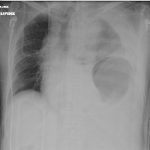The obvious diagnosis is an easy one! An NG tube is seen curled in the stomach, which is located above the diaphragm! This patient has a traumatic rupture of the left diaphragm.
The other, slightly less obvious finding is a spleen injury. Wait, this is a plain chest x-ray. How can we tell there is a spleen injury?
Look at the inside edge of the ribs and the outside of the lung on the patient’s left chest. There is a big, radio-dense gap representing a moderate hemothorax. With injuries to the left diaphragm, the rent is rather large allowing much of the stomach to float up into the chest. The spleen is attached to the greater curve of the stomach by the short gastric vessels. As the stomach moves into the chest, the spleen is dragged up there as well. Typically, it has to squeeze through the hole in the diaphragm and commonly sustains significant injury as it does.
Spleen injury is commonly associated with left diaphragm injury. The usual mechanism for both is blunt force to the left chest and abdomen. It takes major force to rupture the diaphragm, and this is usually associated with t-bone type car crashes on the driver’s side and pedestrians struck on their left side.
Diagnosis is difficult to make by physical exam alone. Breath sounds are decreased on the left, and patients are frequently dyspneic. The most frequent cause for this constellation of symptoms is a pneumothorax or hemothorax, and a chest tube may be inserted on clinical grounds alone. Unfortunately, the tube will not make the symptoms any better. Chest x-ray helps enormously, and an NG tube can be inserted to decompress the stomach and allow better inflation of the left lung when the diaphragm injury is recognized. This will relieve symptoms, but the patient will still need to go promptly to the OR to fix the diaphragm and deal with the spleen.


